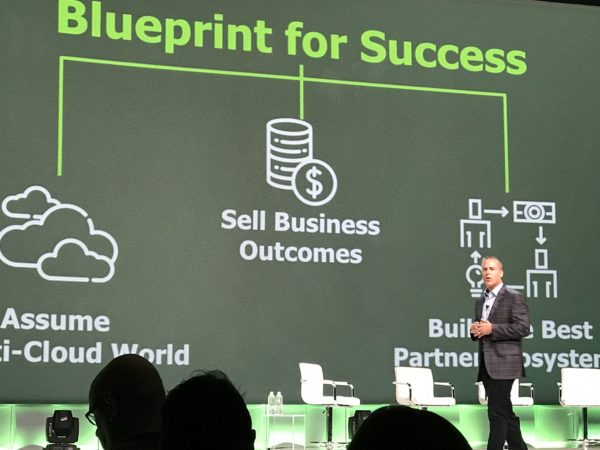
Users today want a seamless digital experience. They want to be able shop online, access their corporate data or crunch sales numbers at home, in the office or in the cafe at any time.
The availability of digital services to customers and employees is of paramount importance to any business today, said Peter McKay, co-chief executive of Veeam Software on May 16. The 10-year-old Veeam provides backup, disaster recovery and virtualisation management software.
But to ensure availability of service every second throughout the year, businesses must also ensure that their information and digital services are protected against outages, lack of capacity and other issues.
Citing figures from research company Gartner, McKay said the addressable market for back-up and recovery industry is about US$6 billion.
“About 50 per cent of this business is generated from companies that are replacing legacy equipment like software and hardware for backup and recovery purpose,” he noted.
“They were first installed in the 1990s and 2000s and they are being replaced in the next two years. Technology has changed over the years and there’s pent-up demand for cost-effective and less complex solutions,” he added.
Veeam wants to seize this opportunity and grab as much of the US$3 billion business that has opened up. McKay is also eyeing the enterprise business, the big Fortune 500 companies that are also looking at reducing cost and complexity in their IT infrastructure.
“This is our newest market. In each location or country, we identify the biggest companies that collect the most data,” said McKay, who was speaking to the media on the sidelines of VeeamON 2017, the company’s annual customer and partner conference held this year in New Orleans.
“They would be the ones who would need back-up and recovery services. Then we hire the domain experts who understand the specific sectors so as to sell and service these companies,” he added.
The company which started from providing virtualisation management services to small and medium companies, is also “growing up”. It is now reaching out to large enterprises in a planned and concerted way.
McKay, who was promoted from chief operating officer to co-CEO earlier this week, pointed out that one of its biggest investments is in hiring domain experts for specific sectors like healthcare, government and financial services.
“These are the areas where there’s a lot of regulations and data collected. They need our services. We need to understand their business challenges, so we formed the global teams of domain experts to tackle this business. They form global strategies which are then customised for different locations and countries,” he said.
But he added that the enterprise market has a long sale cycle. The focus on enterprise sales began two years ago and Veeam is only reaping the rewards in recent months.
These are the key strategies McKay has planned for Veeam to hit US$1.5 billion revenue by 2020, more than double the US$607 million it registered in 2016.
Currently, Veeam has about 231,000 customers worldwide. About 4000 new customers are added a month.
The company, which sells through its channel partners, currently boasts more than 14,000 channel partners including big names like Hewlett-Packard Enterprise, Cisco and VMWare. New partners and alliances will come from new markets that it is expanding quickly in Asia.
“We’ve added about 1000 people to our sales force in the last 12 months. Another 800 more will be added in the next 12 months. We’re also investing US$126 million in marketing activities.”
As Veeam “grows up” to serve larg customers, it also had to adjust its policies internally. Co-founder Ratmir Timashev said that it had to change product licensing and pricing to a subscription model rather than per CPU socket. As a result, payment to its channel partners and remuneration for its sales force were accordingly re-adjusted.
Speaking to reporters on the sideline of VeeamOn, he explained: “For our traditional back-up products customers pay a one-time perpetual licence fee for each CPU socket. They also pay an annual support and maintenance fee. If they don’t pay for support, then they don’t get the software upgrades.
“As more of our business deal with cloud computing, we added a subscription model which allows customers to lower upfront costs while licensing over a defined period of time. These two payment methods will co-exist but we will be moving towards the subscription model in future.”
Payments to channel partners and the sales team had also to be changed in line with the new pricing framework, he added.
About 3,000 business partners and users attended the three-day VeeamOn event here. New products and services announced were centred around business continuity, digital transformation agility and analytics.
Business continuity focusses on instant recovery across cloud platforms. This back-up, replication and continuous data protection offering can be used in multi-cloud or hybrid cloud environment. Digital transformation agility services provides easy, secure and reliable cross-cloud data management and migration.
Analytics solutions will provide customers with actionable insights for data management, operational performance and compliance across their entire IT infrastructure. To do this, Veeam will provide customers with the data analytics and discovery services, simplified data management, workflow automation and other services.
Specifically, the products it announced include the Veeam Availability Suite v10 for business continuity and agility, Veeam Availability for AWS and Veeam Agent for Microsoft Windows
The privately-held company was founded 10 years ago by two Russian entrepreneurs, Timashev and Andrei Baronov who is co-CEO of Veeam. It began as a virtualisation management company for small- and medium-sized businesses.
Grace Chng is a veteran tech writer





